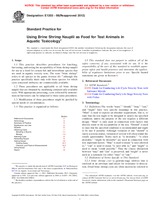We need your consent to use the individual data so that you can see information about your interests, among other things. Click "OK" to give your consent.
ASTM E1203-98(2012)
Standard Practice for Using Brine Shrimp Nauplii as Food for Test Animals in Aquatic Toxicology (Withdrawn 2013)
STANDARD published on 1.12.2012
The information about the standard:
Designation standards: ASTM E1203-98(2012)
Note: WITHDRAWN
Publication date standards: 1.12.2012
SKU: NS-40851
The number of pages: 6
Approximate weight : 18 g (0.04 lbs)
Country: American technical standard
Category: Technical standards ASTM
Annotation of standard text ASTM E1203-98(2012) :
Keywords:
aquatic toxicology, Artemia, brine shrimp, feeding, nutrition, ICS Number Code 13.060.70 (Examination of water for biological properties)
Additional information
| Significance and Use | ||||||||||||||||||||||||||||||||
|
5.1 In certain toxicity tests during which small aquatic animals must be fed, the food of choice is often live brine shrimp nauplii because of their availability, ease of use, and presumed good nutritional quality. In addition, many test species that are cultured or held in the laboratory must be fed prior to toxicity testing, even if they are not fed during the test. 5.2 Brine shrimp nauplii can be readily hatched in the laboratory from cysts that are obtained naturally from many geographical areas around the world. Cysts from a few of those areas are available commercially, but might represent two or more species of brine shrimp (1). 5.3 Nauplii of different strains of the same brine shrimp species from different geographical areas can differ substantially in their nutritional value, contaminants, and acceptability as a complete food for the life stage of the species to which they are fed (3-8). 5.4 The results of a toxicity test can depend on the brine shrimp nauplii used as food (9) . It is desirable to determine prior to use whether a particular batch of brine shrimp is of adequate quality for the test organisms. 5.5 The primary requirements of acceptable brine shrimp are that they are an appropriate size for the test organisms, have adequate nutritional value, and do not contain excessive concentrations of contaminants. Whether a given lot of brine shrimp meets these requirements for a given species can only be determined by a feeding assay. 5.6 Standardization of the hatching, harvesting, testing, and using of brine shrimp will probably increase the reproducibility of results of toxicity tests with some test species by decreasing the use of unhealthy organisms caused by feeding them poor quality brine shrimp. |
||||||||||||||||||||||||||||||||
| 1. Scope | ||||||||||||||||||||||||||||||||
|
1.1 This practice describes procedures for hatching, harvesting, and testing the acceptability of brine shrimp nauplii for use as a food for certain fish and invertebrate species that are used in aquatic toxicity tests. The term “brine shrimp” refers to all species in the genus Artemia (1) 2 although this practice specifically deals only with those species for which cysts (encysted embryos) are commercially available. 1.2 These procedures are applicable to all brine shrimp nauplii that are obtained by incubating commercially available cysts. With appropriate processing, cysts collected by noncommercial harvesters can be subjected to these same procedures. 1.3 Modification of these procedures might be justified by special needs or circumstances. 1.4 This practice is organized as
follows:
1.5 This standard does not purport to address all of the safety concerns, if any, associated with its use. It is the responsibility of the user of this standard to establish appropriate safety and health practices and determine the applicability of regulatory limitations prior to use. Specific hazard statements are given in Section 6. |
||||||||||||||||||||||||||||||||
| 2. Referenced Documents | ||||||||||||||||||||||||||||||||
|
We recommend:
Technical standards updating
Do you want to make sure you use only the valid technical standards?
We can offer you a solution which will provide you a monthly overview concerning the updating of standards which you use.
Would you like to know more? Look at this page.




 Cookies
Cookies
